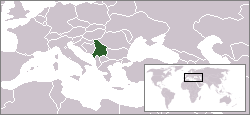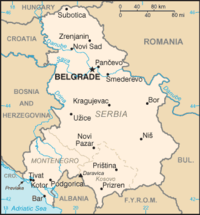 |
|
|
|
Thu, 18 Apr, 2024
|

|

|
Државна заједница
Србија и Црна Гора
Državna zajednica
Srbija i Crna Gora
State Union of
Serbia and Montenegro
 |
 |
Flag of
Serbia and Montenegro |
Coat of Arms of
Serbia and Montenegro |
|
 |
Serbia and Montenegro
– Serbia
– Kosovo and Metohia
(UN administration)
– Vojvodina
– Montenegro |
|
| Official language |
Serbian language written in Cyrillic alphabet |
| Capital |
Belgrade |
| President |
Svetozar Marović |
Area
– Total
– % water |
Ranked 105th
102,350 km²
0.25% |
Population
– Total ( 2005)
– Density |
Ranked 74th
10,829,175
104/km² |
| HDI (2003) |
NA – unranked |
| Currency |
Serbia: Serbian Dinar (CSD)
Montenegro: Euro (EUR) |
Time zone
– in summer |
CET ( UTC+1)
CEST ( UTC+2) |
| National anthem |
Hej Sloveni |
| Internet TLD |
.yu still used ( .cs reserved) |
| Airline carriers |
Jat Airways and Montenegro Airlines |
| Calling Code |
+381 |
- ^ Latin alphabet and more languages are official at various local levels.
- ^ Court of Serbia and Montenegro is in Podgorica.
- ^ Also Chairman of the Council of Ministers.
- ^ in Kosovo and Montenegro the Serbian Dinar is not widespread and the euro is used for most purposes instead.
|
Serbia and Montenegro ( Serbian: Србија и Црна Гора, Srbija i Crna Gora, abbreviated as "SCG") is the name of the state union of Serbia and Montenegro, two former Yugoslav republics. It is located on the west-central Balkan Peninsula, bordering Bosnia and Herzegovina and Croatia on the western sides, Hungary to the north, Romania and Bulgaria to the east, the Republic of Macedonia to the south and Albania to the south-west with just over 200 km of access to the Adriatic.Serbia and Montenegro cooperate in only some political fields (e.g. through a defence union). The states have separate economic policies and currencies. The country does not have a unified capital anymore, dividing its common institutions between Belgrade in Serbia and Podgorica in Montenegro. Each of the two states may seek full independence via a referendum. Montenegro will hold a referendum on this matter on April 30, 2006.The Serb province of Kosovo and Metohia, while a part of Serbia is, since the war of 1999, a United Nations protectorate and de facto outside the control of Serbian and Montenegrin authorities. Its final status is yet to be determined.
 Jump to Page Contents Jump to Page Contents
|
|

Pay as you go
No monthly charges. Access for the price of a phone call
Go>
Unmetered
Flat rate dialup access from only £4.99 a month Go>
Broadband
Surf faster from just £13.99 a month Go> |
Save Even More
Combine your phone and internet, and save on your phone calls
More Info> |
This weeks hot offer
 24: Series 5
24: Series 5
In association with Amazon.co.uk £26.97 |
|
Contents
 History History
 Political divisions Political divisions
 Geography Geography
 Demographics Demographics
 Economy Economy
 Transportation Transportation
 Holidays in Serbia and Montenegro Holidays in Serbia and Montenegro
 Gallery Gallery
 History - Contents History - Contents
Upon the breakup of the Socialist Federal Republic of Yugoslavia, the remaining confederation of Serbia and Montenegro was reconstituted in 1992 as the Federal Republic of Yugoslavia (FRY). However, the United Nations and many individual states (especially the United States) had refused to recognise it as the successor of the former Yugoslavia, although they accepted it as constituting a state. This was due to the ongoing Yugoslav wars, which had prevented agreement being reached on the disposition of federal assets and liabilities, particularly the national debt. The FRY was also suspended from a number of international institutions because of its perceived role in the wars. It was finally re-admitted to the United Nations in 2000 after several years of suspension.In 2002, Serbia and Montenegro came to a new agreement regarding continued co-operation, which, among other changes, promised the end of the name Yugoslavia. On February 4, 2003, the federal parliament of Yugoslavia created a loose commonwealth of Serbia and Montenegro called Serbia and Montenegro. A new Constitutional Charter was agreed to provide a framework for the governance of the country.
 Political divisions - Contents Political divisions - Contents
Serbia and Montenegro comprises four principal political units, consisting of two republics and two subordinate provinces:
-
Serbia (capital: Belgrade)
-
Vojvodina - autonomous province within Serbia (capital: Novi Sad)
-
Kosovo - province within Serbia under United Nations administration (capital: Priština)
-
Montenegro (capital: Podgorica)
The country's political and administrative capital is Belgrade, while its judicial capital is Podgorica.
 Geography - Contents Geography - Contents
Serbia and Montenegro covers an area of 102,350 sq km, with 199 km of coastline. The country's terrain is extremely varied, with much of Serbia comprising plains and low hills (except in the more mountainous region of Kosovo) and much of Montenegro consisting of high mountains. Serbia is entirely landlocked, with the coastline belonging to Montenegro, which also possesses the only fjord in southern Europe. The climate is similarly varied. The north has a continental climate (cold winters and hot summers); the central region has a combination of a continental and Mediterranean climate; the south enjoys an Adriatic climate along the coast, with inland regions experiencing hot, dry summers and autumns and relatively cold winters with heavy snowfall inland.
Belgrade, with its population of 1,717,863, is the country's largest and only significantly sized city. The country's other principal cities are Novi Sad, Niš, Kragujevac, Podgorica, Subotica, and Priština, each with populations of about 100,000-300,000 people.
 Demographics - Contents Demographics - Contents
Serbia and Montenegro has more demographic variety than most other European countries. The three largest named nationalities are Serbs (62.6%), Albanians (mostly Ghegs and Tosks) (16.5%) and Montenegrins (5%) according to the 1991 census. The country also has significant populations of Hungarians, Roma, Bulgarians, Macedonians, Romanians and other eastern Romance peoples (including Aromanians, Megleno-Romanians and Vlachs), and dozens of other Slavic denominations, namely Bosniaks, Croats, Bunjevci, Šokci, Goranci, Janjevci, Rusins, Slovaks, Muslims by nationality and Yugoslavs. Turkic subgroups still live in Kosovo (mostly Gagauz and Seljuks). There is a number of citizens who declare their nationality as Egyptian and Ashkali. These two were previously regarded as a part of Roma who are of the belief that they originated from present-day Egypt and Israel. Most of the ethnic diversity is situated in the provinces of Kosovo and Vojvodina, where smaller numbers of other minority groups may be found. The large Albanian population is chiefly concentrated in Kosovo, with smaller populations in the Preševo and Bujanovac municipalities in Central Serbia, and in the south-east of Montenegro ( Ulcinj municipality). The large Bosniak population live in the Sandžak region on the border between Serbia and Montenegro.
- Total Serbia-Montenegro - 10 019 657
- Serbia (total): 9 396 411
- Vojvodina: 2 116 725
- Central Serbia: 5 479 686
- Kosovo: 1 800 000
- Montenegro: 623 246
- Major cities (over 100,000 inhabitants) - 2002 data (2003 for Podgorica) :
-
Beograd (Belgrade): 1,717,863 (2,000,000 metro)
-
Novi Sad: 215,600 (300,000 metro)
-
Priština: 500,000 (unoficially, no census since 1991)
-
Niš: 253,400 (295,000 metro)
-
Kragujevac: 212,000 (265,000 metro)
-
Podgorica: 139,500 (169,000 metro)
-
Prizren: 120,000 (180,000 metro)
-
Subotica: 99,471 (149,000 metro)
-
Kraljevo: 80,000 (135,000 metro)
-
Pančevo: 78,000 (130,000 metro)
-
Novi Pazar: 76,000 (110,000 metro)
 Economy - Contents Economy - Contents
Mismanagement of the economy, an extended period of economic sanctions, and the damage to Yugoslavia's infrastructure and industry caused by the Kosovo War have left the economy only half the size it was in 1990. Since the ousting of former Federal Yugoslav President Slobodan Milošević in October 2000, the Democratic Opposition of Serbia (DOS) coalition government has implemented stabilization measures and embarked on an aggressive market reform program. After renewing its membership in the International Monetary Fund in December 2000, Yugoslavia continued to reintegrate into the international community by rejoining the World Bank (IBRD) and the European Bank for Reconstruction and Development (EBRD). A World Bank- European Commission sponsored Donors' Conference held in June 2001 raised .3 billion for economic restructuring. An agreement rescheduling the country's .5 billion Paris Club government debts was concluded in November 2001; it will write off 66% of the debt; a similar debt relief agreement on its .8 billion London Club commercial debt has been reached in July 2004; 62% of the debt have been written off.The smaller republic of Montenegro severed its economy from federal control and from Serbia during the Milošević era. Now both republics have separate central banks, different currencies - Montenegro uses the euro, while Serbia uses the Serbian dinar as official currency. The two states also have different customs tariffs, separate state budgets, police forces, governments.The southern Serbian province of Kosovo, while formally still part of Serbia (according to United Nations Security Council Resolution 1244), is moving toward local autonomy under the United Nations Interim Administration Mission in Kosovo ( UNMIK) and is dependent on the international community for financial and technical assistance. The euro and the Yugoslav dinar are official currencies, and UNMIK collects taxes and manages the budget.The complexity of Serbia and Montenegro's political relationships, slow progress in privatisation, and stagnation in the European economy are holding back the economy. Arrangements with the IMF, especially requirements for fiscal discipline, are an important element in policy formation. Severe unemployment remains a key political economic problem. Corruption also presents a major problem, with a large black market and a high degree of criminal involvement in the formal economy.
- Economy statistics: Economy of Serbia
 Transportation - Contents Transportation - Contents
 Map of Serbia-Montenegro
Serbia, and in particular the valley of the Morava is often described as "the crossroads between the East and the West" - one of the primary reasons for its turbulent history. The valley is by far the easiest way of land travel from continental Europe to Greece and Asia Minor. Until the outbreak of the Yugoslav wars, the ironically-named Highway of Brotherhood and Unity running through Croatia, Serbia and Macedonia was one of the Europe's most important transport arteries. It is gradually resuming this role as the security situation is stabilized.Major international highways going through Serbia are E75 and E70. E763/ E761 is the most important route connecting Serbia with Montenegro.The Danube, an important international waterway, flows through Serbia.The largest seaport is Montenegro's Bar.
 Holidays in Serbia and Montenegro - Contents Holidays in Serbia and Montenegro - Contents
Holidays
| Date |
Name |
Notes |
|
January 1 |
New Year's Day |
|
January 7 |
Orthodox Christmas |
|
January 14 |
National Holiday (Serbian New Year) |
"Српска Нова Година"
"Srpska Nova Godina" |
|
January 27 |
Saint Sava's feast Day - Day of Spirituality |
|
April 27 |
Constitution Day |
|
April 29 |
Orthodox Good Friday |
Date for 2005 only |
|
May 1 |
Orthodox Easter |
Date for 2005 only |
|
May 2 |
Orthodox Easter Monday |
Date for 2005 only |
|
May 1 |
Labour Day |
|
May 9 |
Victory Day |
|
June 28 |
Vidovdan ( Martyr's Day) |
In memory of soldiers fallen at the Battle of Kosovo |
- Holidays celebrated only in Serbia
-
February 15 - Sretenje ( National Day)
- Holidays celebrated only in Montenegro
 Gallery - Contents Gallery - Contents
Temple of Saint Sava, Belgrade
|
|
|
|
|
|
|
Millennium bridge, Podgorica
|
Kalenić village in Šumadija
|
|
Change Text Size:
[A]
[default]
[A] |




 |
|
|
|
|